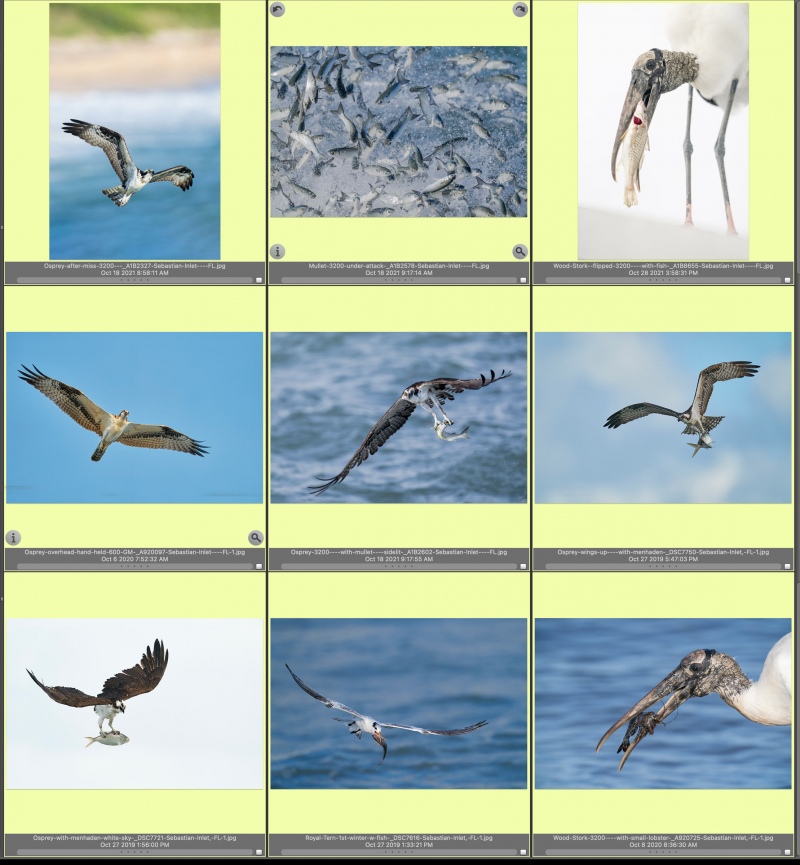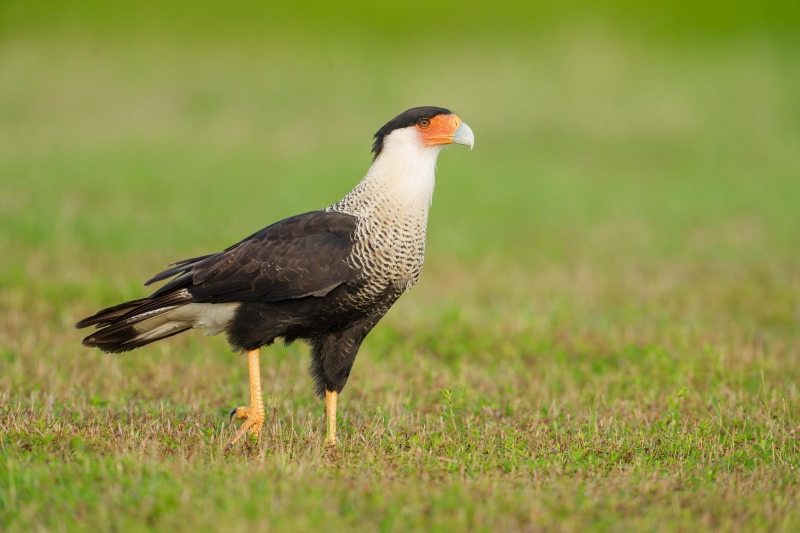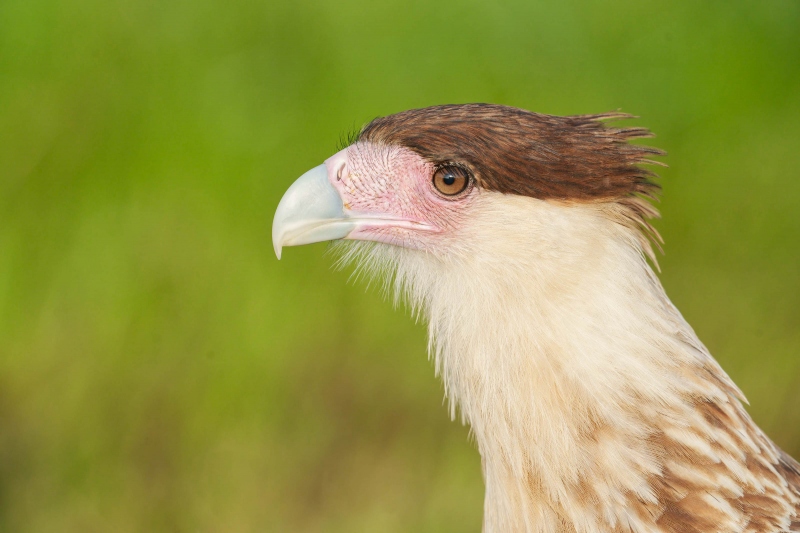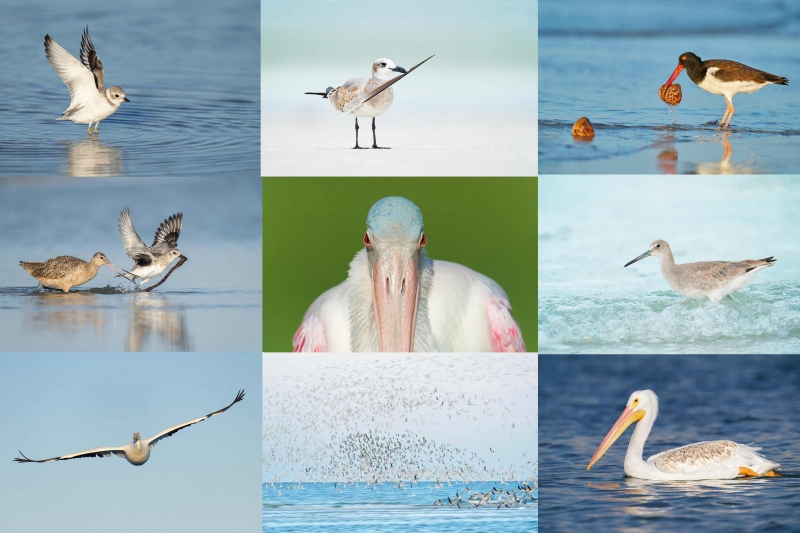My Call
My very favorite David Pugsley image was the American Avocet for its graceful elegance, the soft light, and the low-perspective intimacy.
Your Call?
Which of today’s two featured caracara image do you like best? Be so kind as to leave a comment and let us know why you made your choice.
What’s Up?
Today is Tuesday 17 October 2023. DeSoto is so good that I will be leaving at 4:30am this morning for another busman’s holiday, driving back on Thursday afternoon. If you would like to join me on Tuesday afternoon — the weather looks perfect, or for Wednesday morning or afternoon for an In-the-Field session, shoot me an e-mail or call or text me on my cell at at 863-221-2372. First-timer David Hawkins is joining me on Thursday morning.
A pair of Crested Caracaras raised two handsome young in an. un-photographable nest in a tall cabbage palm in the North Field at Indian Lake Estates last spring. The four of them, all relatively tame, can be seen most mornings foraging in that same field. When I have a free morning with soft light and a wind with an easterly component, I will put out some road kill and try for some incoming flight.
Fort DeSoto #3 Late Registration Discount Info
Shoot me an e-mail if you would like late registration discount information for the third DeSoto Fall IPT.
|
|
|
Clockwise from the upper left back around to center: Osprey gaining altitude after missed strike; school of mullet under attack from below; Wood Stork with Southern Whiting; Osprey with Menhaden; Wood Stork with small lobster; Royal Tern with large baitfish; Osprey with Menhaden; juvenile Osprey directly overhead “t-shot”; Osprey taking flight with freshly caught Mullet. |
Sebastian Inlet In-the-Field Sessions
Join me for 3 hours of morning or afternoon In-the-Field Instruction at Sebastian Inlet for only $300.00/session (or $550 for a full day with two sessions). The main target will be fishing Ospreys hunting for a variety of migrating saltwater fish that visit the inlet each fall. Back-up subjects include fishing gulls, terns, and Brown Pelicans, Wood Stork, a variety of herons and egrets, shorebirds in the afternoon, sunrise cloud-scapes, and the occasional sea turtle or manatee.
October Dates: 21, 22, 24-29, 2023.
November Dates: 6-10, 2023.
Please get in touch via e-mail or call or text me on my cell at at 863-221-2372 to book one or more sessions. Get-well-soon to Jim Miller who had to cancel this weekend at Sebastian.
|
|
|
This image was created on 15 October 2023 at Indian Lake Estates, FL. Working from the driver’s seat of my X5, I used the BLUBB-supported Sony FE 600mm f/4 GM OSS lens, the Sony FE 2.0x Teleconverter, and The One, the Sony Alpha 1 Mirrorless Digital Camera). The exposure was determined via Zebra technology with ISO on the thumb dial. ISO 2500. 1/1000 sec. at f/8 (wide open) in Manual mode. When evaluated in RawDigger, the raw file brightness was determined to be dead-solid perfect. AWB at 7:39:32am as the sun was breaking through the clouds. Tracking: Expand Spot/AF-C with Bird-Eye/Face Detection performed perfectly. Click on the image to enjoy a larger, sharper, high-res version. Image #1: Crested Caracara adult pausing while foraging for bugs |
Long Lens Perspective and the Angle of Declination
There are times when adding a 2X teleconverter (TC) to a long lens is the best move even if you could easily have gotten a lot closer physically. One such example is when you are using your car as a blind and thus, cannot get any lower. I had actually moved my vehicle farther from the bird twice when creating Image #1.
Imagine if I had gotten out of the car with a 400mm lens and was able to walk right up to the bird until it filled about 1/2 the frame (as in Image #1). I would be so close that I would need to have pointed the lens down about 45°. Working from the lowered, driver’s-side window at 1200mm, the lens would have been pointed down only about 10° from the horizontal. When working birds that are lower than you are, the smaller angle of declination, the more intimate your images will be. That is why it looks as if I were close to the ground when photographing the caracara in the first image.
The converse is equally true. When photographing birds above you, the lower the angle of inclination — the number of degrees you need to point your lens up at the subject, the more intimate your images will look.
|
|
|
This image was created on 15 October 2023 at Indian Lake Estates, FL. Working from the driver’s seat of my X5, I used the BLUBB-supported Sony FE 600mm f/4 GM OSS lens, the Sony FE 2.0x Teleconverter, and The One, the Sony Alpha 1 Mirrorless Digital Camera). The exposure was determined via Zebra technology with ISO on the thumb dial. ISO 1250. 1/800 sec. at f/8 (wide open) in Manual mode. When evaluated in RawDigger, the raw file brightness was determined to be dead-solid perfect. AWB at 7:44:34am on partly sunny morning. . Tracking: Expand Spot/AF-C with Bird-Eye/Face Detection performed perfectly. Click on the image to enjoy a larger, sharper, high-res version. Image #2: Crested Caracara — young bird posing |
BLUBB Tip!
This is surely a very fine point, but if you want to make sharp images with your long lens when working on a beanbag, it would be best to pay attention. If your big lens offers Direct Manual Focus (DMF) (most do), and you are working on the world’s best beanbag, the BLUBB (or another inferior bean bag), be sure to move the DMF switch to OFF. If you leave it ON, you can throw off the focus whenever you level the lens or when you recompose. For most shooting, you will want to set the DMF switch to ON so that you can manually prefocus should your AF system become temporarily blind.
Depth of Field Question
Both images were made at the same aperture, f/8, wide open. How do you explain the fact that the background in Image #2 is completely smooth and creamy while much of the background in the first image is relatively sharp and detailed?
|
|
|
All images from SEPT/OCT/NOV at Fort DeSoto. Click on the image to enjoy a larger, sharper high-resolution version. Clockwise from upper left to center: Piping Plover flapping after bath, juvenile Laughing Gull with feather, American Oystercatcher with sea urchins, Willet foraging in surf, American White Pelican juvenile swimming, skimmer/tern/shorebird blast-off blur, American White Pelican in flight, Black-bellied Plover stealing lugworm from Marbled Godwit, Roseate Spoonbill staring. |
The Fall 2023 Fort DeSoto Instructional Photo-Tours
Fall 2023 Fort DeSoto Instructional Photo-Tour #3
3 1/2 Days: Tuesday 31 October through the morning session on Friday 3 November 2023. $1899.00 includes three working lunches. Limit six photographers.
Fall 2023 Fort DeSoto Instructional Photo-Tour #4
3 1/2 Days: Tuesday 14 November through the morning session on Friday 17 November 2023. $1899.00 includes three working lunches. Limit six photographers/Openings: three.
Fall Bird Photography at Fort DeSoto
Fort DeSoto, located just south of St. Petersburg, FL, is a mecca for migrant shorebirds, terns, and gulls in fall. There they join hundreds of egrets, herons, and night-herons that winter on the T-shaped peninsula. With any luck at all, we should get to photograph one of Florida’s most desirable shorebird species: Marbled Godwit. Black-bellied Plover and Willet are easy, American Oystercatcher is pretty much guaranteed. Great Egret, Snowy Egret, Great Blue Heron, Tricolored Heron, and White Ibis are easy as well and we will almost surely come up with a tame Yellow-crowned Night-Heron or two. And there should be some quality Brown Pelican flight photography. In addition, Royal, Sandwich, Forster’s, and Caspian Terns will likely provide us with some good flight opportunities as well. Though not guaranteed, Roseate Spoonbill and Wood Stork might well be expected. And we will be on the lookout for a migrant passerine fallout in the event of a thunderstorm or two.
On this IPT, all will learn the basics and fine points of digital exposure. Nikon and Canon folks will learn to get the right exposure every time after making a single test exposure, and SONY folks will learn to use Zebras so that they can be sure of making excellent exposures before pressing the shutter button. Everyone will learn how to approach free and wild birds without disturbing them, to understand and predict bird behavior, to identify many species of shorebirds, to spot the good situations, to choose the best perspective, to see and understand the light, and to design pleasing images by mastering your camera’s AF system. Most importantly, you will surely learn to evaluate wind and sky conditions and understand how they affect bird photography. And you will learn how and why to work in Manual mode (even if you’re scared of it). The best news is that you will be able to take everything you learn home with you so that you will be a better photographer wherever and whenever you photograph.
|
Clockwise from upper left to center: Long-billed Curlew, juvenile Tricolored Heron, Marbled Godwits, Great Blue Heron, juvenile Pectoral Sandpiper, Wood Stork, smiling Sea Scallop, Ruddy Turnstone scavenging needlefish, Great Blue Heron sunset silhouette at my secret spot, and southbound migrant tern flock blur. |
The Details
There will be a Photoshop/image review session during or after lunch (included) each full day. That will be followed by Instructor Nap Time.
These IPTs will run with only a single registrant (though that is not guaranteed). The best airport is Tampa (TPA). Once you register, you will receive an e-mail with Gulfport AirBnB/VRBO information. If you register soon and would like to share an AirBnB with me, shoot me an e-mail. Other possibilities including taking a cab to and from the airport to our AirBnB and riding with me for $50/day. This saves you both gas and the cost of a rental car.
A $600 deposit is due when you sign up and is payable by credit card. Balances must be paid by check one month before the trip. Your deposit is non-refundable unless the IPT sells out with six folks, so please check your plans carefully before committing. You can register by calling Jim during weekday business hours at 863-692-0906 with a credit card in hand, or by sending a check as follows: make the check out to: BIRDS AS ART and send it via US mail here: BIRDS AS ART, PO BOX 7245, Indian Lake Estates, FL 33855. You will receive a confirmation e-mail with detailed instructions, clothing, and gear advice. Please shoot me an e-mail if you plan to register or if you have any questions on lodging.
Up Early, Stay Out Late!
Obviously, folks attending an IPT will be out in the field early and stay late to take advantage of the sweetest light and sunrise and sunset colors (when possible). The good news is that the days are relatively short in early fall. I really love it when I am leaving the beach on a sunny morning after a great session just as a carful or two of well-rested photographers are arriving. On cloudy days, we may — at the leader’s discretion, stay out in the morning for a long session and skip the afternoon session. To ensure early starts, breakfasts will be your responsibility. And so that we can get some sleep, dinners will sometimes be on your own as well.
Typos
With all blog posts, feel free to e-mail or to leave a comment regarding any typos or errors.



















Colin, I looked on the web and on my A-9, DMF is an option on the top knob on the left side of the camera body. My 200-600 lens also doesn’t have that button, that I’m aware of. I hope artie will enlighten us.
I do not think that DMF switch on a camera body does anything unless the lens offers it …
Correct on the 200-600 not having DMF.
with love, artie
The background in the 2nd image is outside the DOF, therefore it’s blurred. In the 1st image part of the background falls within the DOF and therefore is somewhat in focus. As more of the 1st image background exceeds the DOF, it too becomes blurred. I think. Interesting birds. Would love to see one in person.
Hi Artie, Sorry if this seems dumb but where is the DMF switch on the Sony 600 f4 and the Sony 200-600?
I can find the AF/MF switch but nothing saying DMF
On the 600mm f/4 the Full Time DMF switch is just to the right of the AF/M switch. There are two options, On and Off.
The 200-600 does not offer this great feature — I wish that it did.
with love, artie
Images #1 and #2 Crested Caracara are well made and interesting! And the other images are well made and interesting also! And the first of those images shows a dad or mom holding kids!
PS I think I can see the reflection of your vehicle in the eye on the second image. Another clue that you were fairly close.
The depth of field becomes narrower the closer you get to your subject. In the second image you were using the same focal length but obviously much closer to the bird (since it’s so much larger in the frame) thus the narrow depth of field and the blurred background.